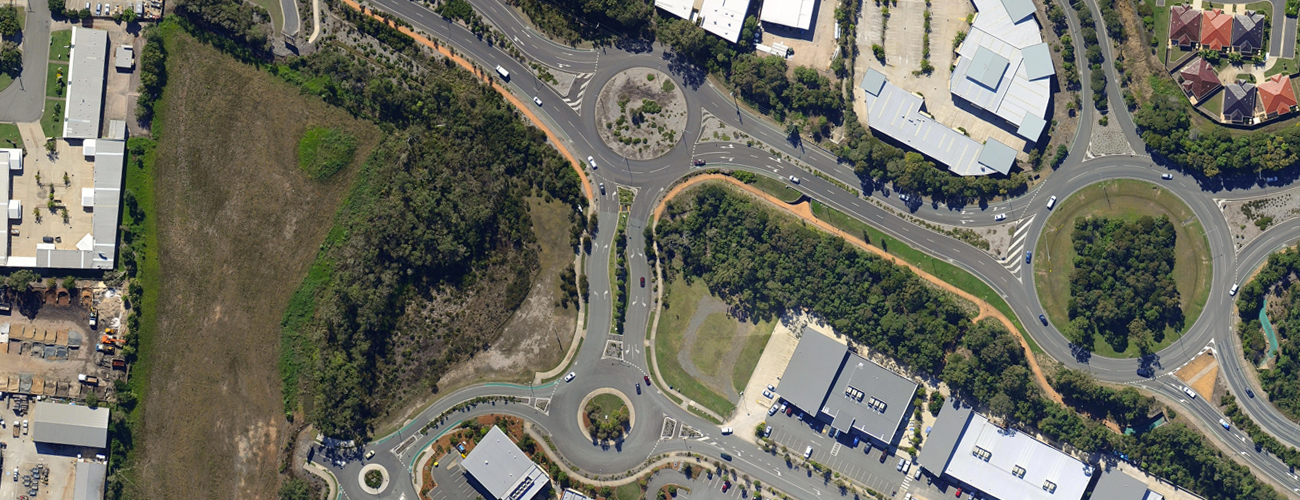Many powerful roundabout model features
SIDRA INTERSECTION is the most advanced software for roundabouts and includes many powerful model features:
Roundabout capacity and performance models developed as part of an integrated performance modelling framework developed considering all types of intersection allows comparison of roundabout design with signalised and sign-controlled intersections in one package using consistent methodology.
Roundabouts with 2 or more entry and circulating lanes with any configuration.
Roundabout corridors and networks with signals, sign-controlled intersections and pedestrian crossings.
Roundabout Level of Service option.
Negotiation speeds and distances and geometric delays estimated.
Capacity constraint method applied to oversaturated lanes as an essential element of roundabout analysis.
Roundabout is treated as an interactive system for modelling of unbalanced flow conditions.
Effect of upstream signals on capacity is taken into account by determining extra bunching in circulating flows.
Unique method for analysis of metering signals on one leg of the roundabout.
Environment Factor parameter for easy model calibration for different local conditions.
The effects of driver yield behaviour and roundabout geometry factors on capacity and level of service are taken into account using a unique lane-by-lane analysis method combined with gap-acceptance parameters that are empirically based.
The effect of roundabout geometry parameters (roundabout size, circulating road width, entry radius, entry angle, etc.) on capacity included.
Critical Gap and Follow-Up Headway Reduction with increasing demand flows in design life analysis.
Effect of Heavy Vehicles and other Movement Classes on capacity taken into account using the Gap Acceptance Factor and Opposing Vehicle Factor parameters.
The US HCM Software Setup in SIDRA INTERSECTION uses the HCM Edition 6 roundabout capacity model as the default model, continues to offer the HCM 2010 roundabout capacity model option, and offers the SIDRA Standard roundabout capacity model option with default Environment Factors of 1.05 for single-lane roundabouts and 1.20 for two-lane roundabouts to match the lower capacity estimates based on US roundabout research.
Roundabout Capacity Model in HCM Edition 7 is the same as the model in HCM Edition 6. Therefore, we continue to use the name "HCM 6 Roundabout Capacity Model".
Articles comparing the features of SIDRA Standard model, HCM model described in Highway Capacity Manual Edition 6, and the UK TRL model implemented in the RODEL and ARCADY software can be found under Publications.
The features compared include methodology, model level of detail (lane-based or approach-based), parameters used in the model to represent driver behaviour and roundabout geometry, and model calibration methods.
Extensions SIDRA INTERSECTION offers to HCM for Roundabouts
The Highway Capacity Manual acknowledges the need to use alternative models in view of various shortcomings of the HCM. Major extensions to the capacity and performance estimation method when the HCM 6 and HCM 2010 roundabout capacity models are used in SIDRA INTERSECTION are listed below in summary form.
- Roundabout corridors and networks with signals, sign-controlled intersections and pedestrian crossings.
- Roundabouts with more than 2 entry and circulating lanes with any configuration.
- Effect of upstream signals on capacity.
- Unique method for analysis of roundabout metering signals.
- Capacity constraint method applied to oversaturated lanes as an essential element of roundabout analysis.
- Treatment of a roundabout as an interactive system for modeling of unbalanced flow conditions.
- Entry and circulating lane flow rates calculated allowing for lane under-utilisation.
- Bypass lanes (shared and exclusive with yield control and continuous lanes).
- Short lane capacity with excess queue into adjacent lanes.
- Different Movement Classes can be assigned to specific lanes, e.g. Bus lanes.
- Effect of Heavy Vehicles and other Movement Classes on capacity taken into account using the Gap Acceptance Factor and Opposing Vehicle Factor
- An alternative Roundabout Level of Service option.
- Capacity Model Calibration Factor parameter for easy model calibration for different local conditions.
- Estimates of negotiation speeds and distances and geometric delays.
- Back of queue and probability of blockage models for queue spillback effects on upstream lane capacity.
- Estimates of stop rates and proportion queued.
- Time-proven models of fuel consumption, emissions and operating cost.
The SIDRA standard roundabout capacity model option offers the following additional features:
- The effect of roundabout geometry parameters (roundabout size, circulating road width, entry radius and angle, etc.) on capacity.
- Critical Gap and Follow-Up Headway Reduction with increasing demand flows in design life analysis.
